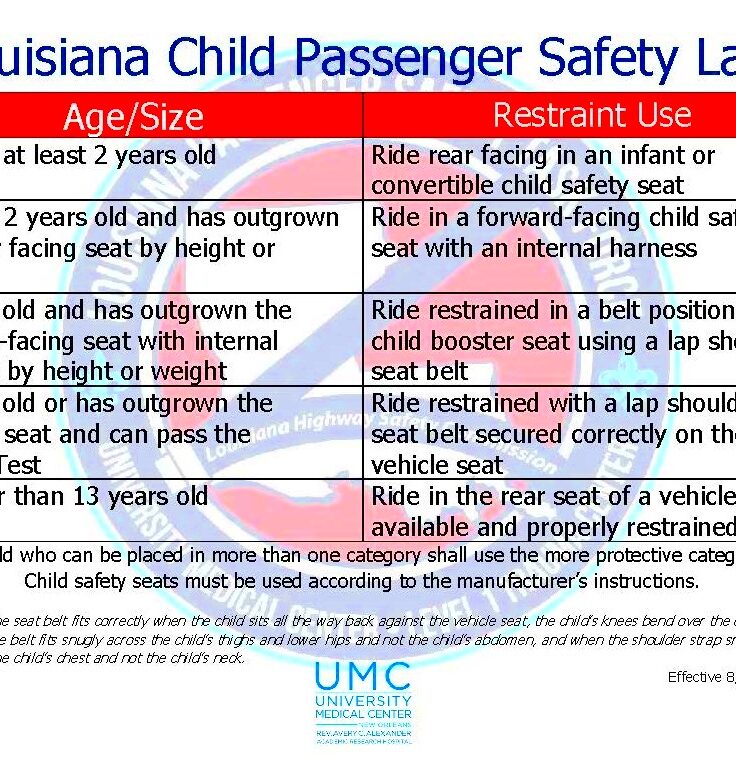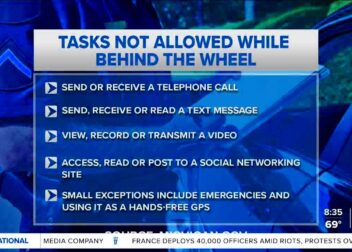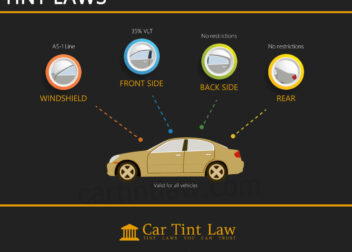Louisiana’s Child Passenger Safety Laws Simplified
Understanding the child passenger safety laws of Louisiana is something you must know if you wish to keep your kids safe in cars.
A great deal of regulations and recommendations out there sometimes leave me feeling lost as a parent. Louisiana has special laws that require children to be restrained properly during transportation. They aim not only to meet legal requirements but also to safeguard our most valuable load, which is kids.
In Louisiana, the law requires that children under the age of 13 must be seated in the back seat of a vehicle when possible. This is because the back seat is generally considered safer during a crash. Additionally, the law stipulates the use of age-appropriate child safety seats, which can vary based on a child’s weight and height.
Importance of Child Passenger Safety

Child passenger safety is not just about following the law; it’s about ensuring our children’s well-being. I remember a family road trip where we took every precaution—double-checking the car seat and ensuring it was securely fastened. It was a comfort to know that our kids were safe, allowing us to focus on enjoying the journey. Statistics show that properly used child safety seats reduce the risk of fatal injury by 71% for infants and 54% for toddlers in passenger cars. Those numbers aren’t just figures; they represent lives saved and families kept whole.
Who Needs to Use Child Safety Seats
The clear regulations about child safety seats for specific age groups are a requirement by law in Louisiana. Here is a short outline:
- Infants (0-1 year): Must be in a rear-facing car seat.
- Toddlers (1-4 years): Should remain in a rear-facing seat until they reach the maximum height or weight limit, then transition to a forward-facing seat.
- Children (4-8 years): Must be in a booster seat until they can use the vehicle’s seat belt safely.
- Children (8-13 years): Must use a seat belt and should sit in the back seat when possible.
Understanding that these categorizations are not mere suggestions is paramount; they are protective policies based on evidence. Once I saw a mom grappling with placing her kid into a booster seat. However, taking time to assist her was more than an act of kindness; it was also a reminder of the dire need for collective action in ensuring road safety for children.
Types of Child Safety Seats Available
It feels like finding your way through a labyrinth while selecting the perfect child safety seat. With countless varieties available in the market, it’s just too easy to get lost in them. As I recall, when my baby girl came into this world, I spent endless hours searching. The state of Louisiana recognizes different categories of child safety seats as defined by age and size. Familiarizing oneself with the various types can enable you to keep your child safe and secure.
- Infant Car Seats: These are designed for newborns and small babies, typically weighing up to 22-35 pounds. They should always be placed in a rear-facing position. The snugness of these seats provides maximum protection in case of a collision.
- Convertible Car Seats: Suitable for infants and toddlers, these can be used in both rear-facing and forward-facing positions. They accommodate larger weights and can last through multiple stages of your child’s growth.
- Booster Seats: Once children outgrow their convertible seats, they need a booster seat to ensure the vehicle’s seat belt fits correctly. These seats elevate the child so that the seat belt can rest properly across their lap and chest.
- All-in-One Seats: As the name suggests, these can transition from rear-facing to forward-facing to a booster seat, providing long-term use.
Whenever I happen to catch sight of a kid all migrated into the car seat so snugly like a tortoise in its shell, I feel relieved that our safety comes first. It’s not merely obeying rules set out by the authorities; but rather it is an expression of compassion towards those small ones among us.
Proper Installation of Child Safety Seats
That was one of the most severe situations I’ve ever witnessed! I still remember the time when my friend thought he knew how to install a child safety seat. Then in that safety check we realized that it wasn’t even fastened properly! People often assume that fitting a car seat is an easy task, but it does require focus and precision.
Here are some essential tips for appropriate installation:
- Read the Manual: Both the car seat and the vehicle’s manual should be consulted. Each model has specific instructions that are crucial for safe installation.
- Secure Fit: Ensure the seat is tightly installed. It shouldn’t move more than an inch side to side or front to back.
- Use the Right Anchors: Most modern vehicles come with LATCH (Lower Anchors and Tethers for Children) systems that make installation easier. However, if your vehicle doesn’t have LATCH, using the seat belt is just as safe if done correctly.
- Check the Angle: For rear-facing seats, ensure the angle is appropriate. Many seats come with built-in indicators to help with this.
Do not forget that it is quite difficult to install them, so if you need help don’t hesitate to ask. It is common for your local fire department or child passenger safety technologists to do free inspections on car seats. One of the most important things we must do as parents is keep our children safe in cars.
Exceptions to the Child Passenger Safety Laws
In Louisiana, children are protected by child passenger safety laws that are exceptions to the rules. But there are exceptions to this case worth mentioning. Actually, things are rarely that simple; sometimes a situation may arise when regulations become arbitrary. Hence to be on the safe side and ensure legality, it is important to note these exceptions.
Some notable exceptions include:
- Medical Exemptions: In certain cases, a child with a medical condition may be exempt from using standard safety seats. A doctor’s note is usually required to validate this.
- Vehicles Without Back Seats: For vehicles that do not have a back seat, such as some sports cars, children may be allowed to sit in the front with the appropriate safety restraints.
- Ride Sharing Services: When using ride-sharing services, the laws can be a bit murky. While it’s recommended to bring your own car seat, some services may not have policies that require it.
Nonetheless, exceptions do exist but should be treated very carefully. Once I had an instance in which a friend lacked a car seat during an emergency situation. We really managed to cope up but it’s a lesson about being well prepared in life. Knowing the details will always assist you in keeping your kids secure despite any changes that may take place.
Enforcement of Child Passenger Safety Laws in Louisiana
It is very important to enforce child passenger safety laws to keep our children safe on the road. At times, this can be overwhelming for parents as they try to follow all of the rules that seem to have been left behind by most drivers. In Louisiana, police departments have an important part in making sure that these laws are observed, but only a concerted effort from parents and other members of society can genuinely make a difference.
It can include different actions that are taken to make these laws work:
- Traffic Stops: Police officers may stop vehicles if they observe children not wearing seat belts or being improperly secured in their seats.
- Checkpoints: During certain campaigns, law enforcement sets up checkpoints specifically to check for compliance with child safety laws. These are often announced in advance to educate the public.
- Public Awareness Campaigns: Local governments often collaborate with organizations to promote awareness about the importance of child passenger safety. I recall attending an event where local police demonstrated proper car seat installation. It was eye-opening and reinforced the community’s commitment to keeping children safe.
The same should apply for you as a parent. Every time we strap our child in a safety seat, it’s like we’re pledging to safeguard them. However much small in scale, having everyone involved produces a safer society that will ultimately result in fewer road wrecks and injuries.
Resources for Parents and Caregivers
When it comes to child passenger safety, it is the parents and caregivers who feel the difference if they are able to find trustworthy resources. In my quest about parenthood I often consulted community sources in order to be prepared and informed. Fortunately, there are numerous institutions and websites that offer assistance in dealing with problems related to child safety.
This is a collection of priceless assets:
- National Highway Traffic Safety Administration (NHTSA): Their website offers detailed information on car seat safety, installation guides, and recalls.
- Safe Kids Worldwide: This organization provides information about local events and safety seat checks. They often host workshops that focus on proper usage and installation.
- Local Health Departments: Many offer free car seat inspections and education programs to help parents understand the laws and best practices.
- Community Groups: Connecting with local parenting groups on social media can be incredibly helpful. I’ve found many parents sharing experiences, tips, and even organizing group purchases for car seats.
Accumulating insight regarding these assets empowers us to make our choices wisely. It’s said that knowledge is power, and when it pertains to the safety of our kids, that’s all that counts.
Frequently Asked Questions about Louisiana’s Child Passenger Safety Laws
When it comes to understanding Louisiana’s child passenger safety laws, questions may arise from new parents and other concerned parties. I mean, with so much information available, it is only normal for one to feel confused. I still recall the time my first daughter was born; I had so many questions regarding the best for her safety. Below are some commonly asked questions which might help in solving this dilemma:
- What age can my child sit in the front seat? In Louisiana, children under 13 years old should sit in the back seat for optimal safety.
- Do I need a special seat for my toddler? Yes, toddlers should use a forward-facing car seat once they exceed the weight limit for rear-facing seats.
- Are there penalties for not using a car seat? Yes, failing to use an appropriate child safety seat can result in fines and points on your driving record.
- What should I do if I can’t afford a car seat? Many local charities and organizations offer assistance or free car seats to families in need. Reach out to community resources for support.
It’s good parenting to ask questions and seek clarity. We not only protect our children by being informed but also make the whole community safer. Hence, it is important to remember that one can ask for help and assistance when it’s required.
Conclusion on Keeping Children Safe in Vehicles
The weight of protecting our children in automobiles falls hard on us as parents. With every time I attach my children into their car seats, I have both relief and tension. It is more than just obeying the law; it is establishing security for our beloved ones. The car safety regulations for kids in Louisiana serve as a guide to enable us to choose wisely, however, it’s our daily behaviors that counts the most.
It must not be forgotten that education is where safety begins, and from that point onwards, it is about awareness. There are so many small things we can do which play significant roles in overall safety vibes, like correctly fixing a child restraint system into your automobile or participating in neighborhood protection activities. We could share experiences as mothers or fathers; often when I listen to other people’s narratives on their challenges and victories concerning their kids’ wellbeing, I feel just fine again.
To put it simply, we want to keep them safe as they develop. We are able to make the roads much safer for our kids if we put safety first, are informed, and help each other as we raise our children. Let us take this burden on together as every little thing that we do counts in securing the lives of our children.


